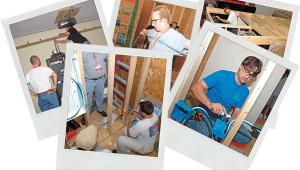Atmos Makeover: A Space Odyssey, Part 1
While I never personally installed the height or width-channel formats in my theater, I had heard some demos and never was very impressed with them. Atmos, however, is different from anything that preceded it. It’s an “object-based” surround format originally developed for cinema that allows movie sound mixers to place sound sources (the objects) anywhere inside the theater, including overhead.
When Atmos was first announced for the theater back in 2012, I was excited to go and hear it for myself. Unfortunately, the closest theater was over 60 miles away and I wasn’t willing to cross two bridges and pay for parking in San Francisco just to hear overhead speakers with object-based sound mixing. I’ve still yet to hear an Atmos soundtrack in a movie theater—although my daughter has and raves about it. But I’m quite happy it’s finally come to the home, because I’d rather watch a movie in my theater versus the overpriced cineplex anyway.
In October 2014, Dolby released its formal Atmos Home Theater Installation Guidelines, and I couldn’t wait to read it. I blasted through the 37 pages, but by the end I was very disappointed. While Atmos for the home sounded like a surefire winner, the setup parameters would be virtually impossible to implement in my unusual space. My home theater is in a family room with a cathedral ceiling that starts at just over nine feet tall and stops at a peek of 16 feet, 8 inches, which meant that using Atmos-enabled speakers to “bounce” the sound off the ceiling was out of the question. Also, my room’s setup options are limited due to connected living spaces—namely the kitchen and dining room as well as a main thoroughfare through the house to the backyard. That means the four primary surround speakers in my 7.1-channel system (side and back surrounds) would have to remain mounted in their existing positions, which is higher on the wall than Dolby suggests for Atmos (ear height when seated). So my excitement over Atmos waned and I shelved the idea.
Over the next couple of months, though, I couldn’t get the idea of Atmos out of my mind and started to brainstorm various options—convert another room in the house into my theater, sell my house and move to one with a more suitable room, add-on to my existing home, roll the dice and do the best implementation possible in my existing room? In the end, I decided to roll the dice for a variety of reasons. First, it was the one most likely to succeed financially because I had to sell this idea to my wife, sometimes known as “she who must not be crossed.” So, as the consummate salesman, I went to work on my better half.
In a well prepared presentation, I laid out the reasons why we needed an Atmos system in our home and gave her two different options for proceeding with the installation. Option 1 was to keep our existing room “as is” and I’d custom-build speaker enclosures for our ceiling that would hang down into the room to place the Atmos overhead speakers in the proper place and angle. My second pitch—and the one I truly wanted—was to finally do something I’d always wanted to: lower the ceiling in the room to 127 inches (10 feet, 7 inches), a suggestion I’d made when we moved into the house back in 2000 that was instantly rejected.

I took the time to make scale drawings with my ideas, break down the cost of construction (about $1,500 with the majority of the labor from myself and a couple of friends who had offered to help) and the additional equipment needed (a new Atmos-capable pre/pro, four overhead speakers for the Atmos height channels, additional amplification, wiring, etc.). This part was harder to budget for because you never know what you’ll get for your old equipment on the used market, but I budgeted $2,500 here for out-of-pocket costs. As I moved in for the final close, I also explained how I could recoup the cost over time by bumping up my writing gig for Sound & Vision, since having an Atmos system installed would open up more review opportunities for me (subtle hint being sent Rob’s way right now).
Surprisingly, she agreed to the remodel with one condition—the overhead space that was being created had to become a storage area for her use, which I instantly agreed to. Once I had this agreement from her on the basic reno I made one last pitch for something I’d also wanted to do for years—painting the ceiling black, which would theoretically help reduce light reflections off the ceiling and possibly improve the contrast performance of my JVC projector. She wasn’t a fan of the idea at all but was willing to give it a look with one caveat—if she didn’t like it I’d have to paint it back to white at my first opportunity.
Ultimately, even with my planned room changes, I still wouldn’t totally conform to the Dolby Atmos specs. My surround speakers were going to be higher than they specify, but the more I thought about it I realized that I was probably not be alone in my predicament. If I wrote an article about my renovation and described the end result, other enthusiasts could learn whether converting a more traditional room to Atmos would actually work. I can’t be the only guy out there that can’t lower their surround speakers, can I?






























































